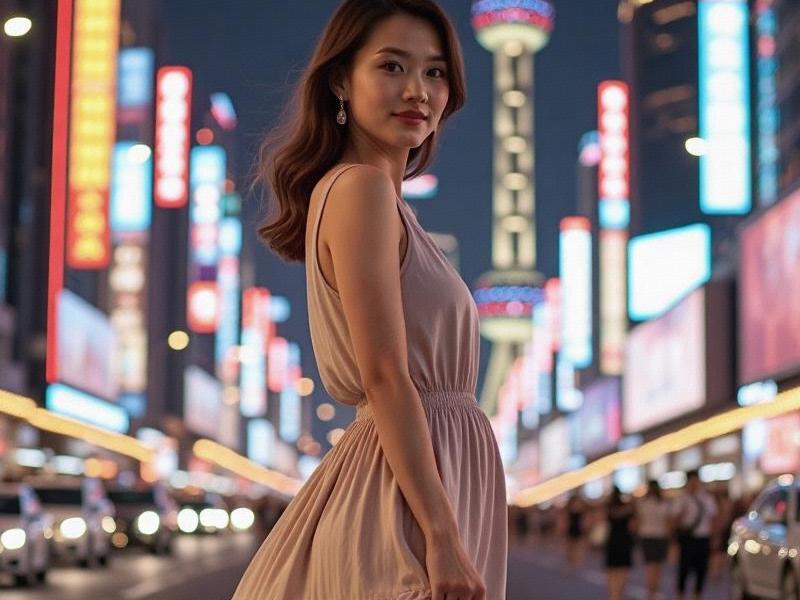An in-depth exploration of how Shanghai women are redefining Chinese beauty standards through a unique blend of traditional aesthetics and global influences in China's most cosmopolitan city.

The Shanghai Aesthetic:
Shanghai has long been China's beauty capital, where local women have pioneered distinctive styles that blend Eastern elegance with Western boldness. The typical Shanghai woman in 2025 embodies:
- The "qingchun" (youthful) look with dewy skin and natural makeup
- "Xianxi" (delicate) fashion sense favoring tailored silhouettes
- "Jingzhi" (precise) attention to detail in accessories
- "Guoji" (international) openness to global trends
Historical Foundations:
Shanghai's beauty traditions trace back to:
1. 1920s Qipao Era: The body-hugging cheongsam first gained popularity
2. 1930s Hollywood Influence: Permed hair and bold lipstick emerged
3. 1980s Reform Period: Western cosmetics entered the market
4. 2000s K-Beam Wave: Korean beauty trends dominated
5. 2020s Cultural Confidence: Revival of hanfu with modern twists
Beauty Economy Boom:
Shanghai's cosmetics market shows staggering growth:
- $3.2 billion annual spending on beauty products
- 8,500+ beauty salons (highest density in China)
- 37% of Chinese cosmetic brands headquartered in Shanghai
- 92% of local women use at least 5 skincare products daily
上海龙凤阿拉后花园 - 68% undergo regular professional treatments
Fashion Districts as Cultural Hubs:
Key areas defining Shanghai's beauty landscape:
1. Nanjing Road:
- Historic department stores with luxury beauty counters
- Flagship stores of Chinese brands like Florasis
2. Xintiandi:
- Boutique spas offering TCM-based treatments
- Fusion beauty concepts like tea-infused facials
3. West Bund:
- Avant-garde beauty tech startups
- AR makeup testing stations
4. Tianzifang:
- Independent designers blending traditional crafts
- Custom qipao ateliers using smart fabrics
上海龙凤419油压论坛
The New Shanghainese Woman:
Modern Shanghai women are redefining beauty through:
- "Smart Beauty" apps analyzing skin via AI
- Sustainable cosmetics with Chinese herbal ingredients
- Gender-neutral fashion movements
- Body positivity campaigns
- Cosmetic surgery tourism to Korea and Japan
Cultural Preservation:
Traditional elements experiencing revival:
- Hair ornaments modeled after Ming Dynasty styles
- Natural dyeing techniques for eyebrows
- Jade facial rollers used since Song Dynasty
- Herbal compress therapies from TCM
Global Influence:
Shanghai beauty trends gaining international recognition:
- "Glass skin" technique adapted from K-beauty
- "Fox eye" makeup inspired by Chinese opera
上海贵族宝贝自荐419 - Hanfu street fashion featured in Vogue
- TCM skincare lines sold at Sephora worldwide
Challenges and Controversies:
Ongoing debates in Shanghai's beauty scene:
- Western vs. Chinese beauty standards
- Cosmetic surgery addiction among young women
- Workplace discrimination based on appearance
- Sustainability in packaging and production
Future Directions:
Emerging trends to watch:
1. "Tech-Enhanced Beauty" combining wearables with skincare
2. Custom 3D-printed makeup
3. VR makeup tutorials
4. DNA-based skincare regimens
5. Traditional Chinese medicine meets biotechnology
Conclusion:
Shanghai women continue to lead China's beauty evolution, creating a distinctive style that honors cultural heritage while embracing global innovation. Their approach reflects the city's unique position as both guardian of tradition and pioneer of the future.